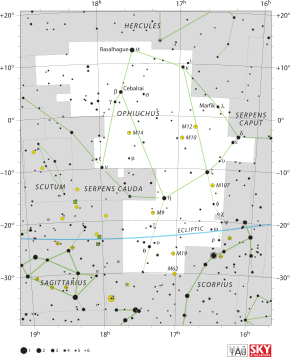Ophiuchus
| Constellation | |
 | |
| Abbreviation | Oph |
|---|---|
| Genitive | Ophiuchi |
| Pronunciation | /ˌɒfiːˈjuːkəs/ Óphiúchus, genitive /ˌɒfiːˈjuːkaɪ/ |
| Right ascension | 17 |
| Declination | 0 |
| Area | 948 sq. deg. (11th) |
| Main stars | 10 |
| Bayer/Flamsteed stars | 62 |
| Stars with planets | 5 |
| Stars brighter than 3.00m | 5 |
| Stars within 10.00 pc (32.62 ly) | 8 |
| Brightest star | α Oph (Ras Alhague) (2.1m) |
| Messier objects | 7 |
| Meteor showers | Ophiuchids Northern May Ophiuchids Southern May Ophiuchids Theta Ophiuchids |
| Bordering constellations | Hercules Serpens Caput Libra Scorpius Sagittarius Serpens Cauda Aquila |
| Visible at latitudes between +80° and −80°. Best visible at 21:00 (9 p.m.) during the month of July. | |
Ophiuchus is a large constellation located around the celestial equator. Its name is Greek (Ὀφιοῦχος) for 'snake-holder', and it is commonly represented as a man grasping the snake that is represented by the constellation Serpens. Ophiuchus was one of the 48 constellations listed by the 2nd century astronomer Ptolemy, and it remains one of the 88 modern constellations. It was formerly referred to as Serpentarius (/ˌsɜrpənˈtɛəriəs/), a Latin word meaning the same as its current name.
Ophiuchus is a zodiacal constellation (meaning that the Sun passes through it during the course of the year), but unlike the other twelve, it is not associated with an astrological sign. As of 2008, the Sun passes through Ophiuchus between November 30 and December 17.[1]
Location
It is located between Aquila, Serpens and Hercules, northwest of the center of the Milky Way. The southern part lies between Scorpius to the west and Sagittarius to the east. It is best visible in the northern summer and located opposite Orion in the sky. Ophiuchus is depicted as a man grasping a serpent; the interposition of his body divides the snake constellation Serpens into two parts, Serpens Caput and Serpens Cauda, which are nonetheless counted as one constellation.
Notable features
Stars

The brightest stars in Ophiuchus include α Ophiuchi, called Rasalhague (at the figure's head), and η Ophiuchi.
RS Ophiuchi is part of a class called recurrent novae, whose brightness increase at irregular intervals by hundreds of times in a period of just a few days. It is thought to be at the brink of becoming a type-1a supernova.[2]
Barnard's Star, one of the nearest stars to the Solar System (the only stars closer are the Alpha Centauri binary star system and Proxima Centauri), lies in Ophiuchus. (It is located to the left of β and just north of the V-shaped group of stars in an area that was once occupied by the now-obsolete constellation of Taurus Poniatovii, Poniatowski's Bull.)
In 2005, astronomers using data from the Green Bank Telescope discovered a superbubble so large that it extends beyond the plane of the galaxy.[3] It is called the Ophiuchus Superbubble.
In April 2007, astronomers announced that the Swedish-built Odin satellite had made the first detection of clouds of molecular oxygen in space, following observations in the constellation Ophiuchus.[4]
The supernova of 1604 was first observed on October 9, 1604, near θ Ophiuchi. Johannes Kepler saw it first on October 16 and studied it so extensively that the supernova was subsequently called Kepler's Supernova. He published his findings in a book titled De stella nova in pede Serpentarii (On the New Star in Ophiuchus' Foot). Galileo used its brief appearance to counter the Aristotelian dogma that the heavens are changeless.
In approximately 40,000 years Voyager 1 probe will pass within 1.6 light years of the star AC+79 3888, which is located in Ophiuchus.[5]
Deep-sky objects
Ophiuchus contains several star clusters, such as IC 4665, NGC 6633, M9, M10, M12, M14, M19, M62, and M107, as well as the nebula IC 4603-4604. The unusual galaxy merger remnant NGC 6240 is also in Ophiuchus.
In 2006, a new nearby star cluster was discovered associated with the 4th magnitude star Mu Ophiuchi.[6] The Mamajek 2 cluster appears to be a poor cluster remnant analogous to the Ursa Major Moving Group, but 7 times more distant (approximately 170 parsecs away). Mamajek 2 appears to have formed in the same star-forming complex as the NGC 2516 cluster roughly 135 million years ago.[7]
Mythology
This section possibly contains original research. (December 2008) |

There exist a number of theories as to whom the figure represents.
The most recent interpretation is that the figure represents the healer Asclepius, who learned the secrets of keeping death at bay after observing one serpent bringing another healing herbs. To prevent the entire human race from becoming immortal under Asclepius' care, Zeus killed him with a bolt of lightning, but later placed his image in the heavens to honor his good works. It has also been noted that the constellation Ophiuchus is in close proximity in the sky to that of Sagittarius, which has at times been believed to represent Chiron (the mentor of Asclepius and many other Greek demigods), though Chiron was originally associated with the constellation Centaurus.
Another possibility is that the figure represents the Trojan priest Laocoön, who was killed by a pair of sea serpents sent by the gods after he warned the Trojans not to accept the Trojan Horse. This event was also memorialized by the sculptors Agesander, Athenodoros, and Polydorus in the famous marble sculpture Laocoön and his Sons, which stands in the Vatican Museums.
A third possibility is Apollo wrestling with the Python to take control of the oracle at Delphi.
A fourth is the story of Phorbas, a Thessalonian who rescued the people of the island of Rhodes from a plague of serpents and was granted a place in the sky in honor of this deed.
Astrology


Although Ophiuchus intersects the ecliptic, it is not a zodiacal sign in most versions of astrology. The signs are defined as 30-degree segments of the ecliptic, of which there are twelve, and they are named after nearby constellations at the time the system was developed, rather than being defined by the modern constellations. However, a few sidereal astrologers (such as Walter Berg) consider the Sun to be in the sign Ophiuchus when it is in the constellation Ophiuchus, which as of 2008[update] is November 30 to December 17. Since Ophiuchus is identified with Aesculapius, the Staff of Aesculapius is often used as a symbol for Ophiuchus. In Japan, an astrological symbol for Ophiuchus is in widespread use. The symbol is sufficiently common to be included in emoji,[8] and appears in the Final Fantasy video game series.[9]
Although not incorporated into the 12-sign zodiac, Ophiuchus and some of the fixed stars in it were sometimes used by astrologers in antiquity as extra-zodiacal indicators (i.e. astrologically significant celestial phenomena lying outside of the 12-sign zodiac proper). An anonymous 4th century astrologer, often known as Anonymous of 379, seems to have associated "the bright star of Ophiuchus", likely α Ophiuchi, with doctors, healers or physicians (ἰατρῶν).[10]
Citations
- ^ [1]
- ^ Star 'soon to become supernova'. BBC News, 2006-07-23
- ^ "Huge 'Superbubble' of Gas Blowing Out of Milky Way". PhysOrg.com. 2006-01-13. Retrieved 2008-07-04.
- ^ Molecular Oxygen Detected For The First Time In The Interstellar Medium
- ^ Voyager - Mission - Interstellar Mission
- ^ Mamajek, Eric E. (2006). "A New Nearby Candidate Star Cluster in Ophiuchus at d = 170 pc". Astronomical Journal. 132: 2198. doi:10.1086/508205.
- ^ Jilinski, E., Ortega, V.G., de la Reza, R., Drake, N.A., and Bazzanella, B. (2009). "Dynamical Evolution and Spectral Characteristics of the Stellar Group Mamajek 2". Astrophysical Journal. 691: 212. doi:10.1088/0004-637X/691/1/212.
{{cite journal}}: CS1 maint: multiple names: authors list (link) - ^ http://www.unicode.org/~scherer/emoji4unicode/snapshot/utc.html#e-037
- ^ http://finalfantasy.wikia.com/wiki/Zodiac_%28Term%29
- ^ Franz Cumont and Franz Boll, Catalogus Codicum Astrologorum Graecorum, Vol. 5, part 1, Brussels, 1904, pg. 210.
References
- Ian Ridpath and Wil Tirion (2007). Stars and Planets Guide, Collins, London. ISBN 978-0007251209. Princeton University Press, Princeton. ISBN 978-0691135564.
External links
